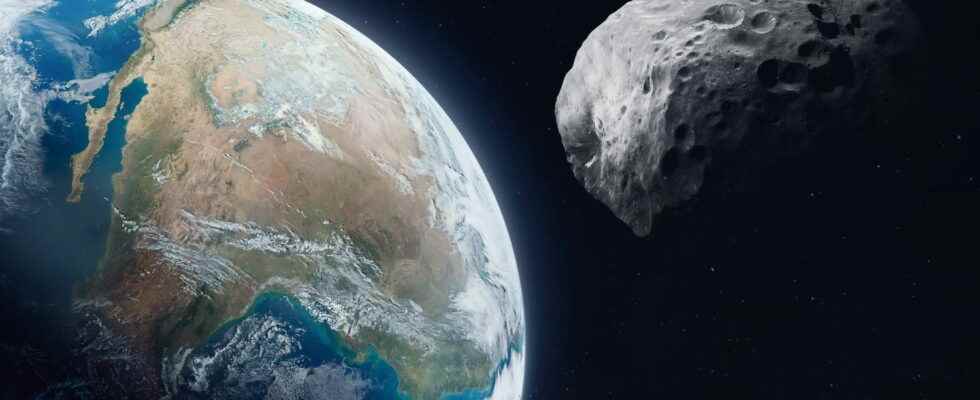ASTEROID. An asteroid the size of an Olympic swimming pool could cross Earth’s path in 2046. While the chances of a collision are minimal, 2023 DW is currently under close surveillance by NASA.
Discovered on February 26, 2023 by a Chilean telescope, 2023 DW is an asteroid that could collide with Earth on February 14, 2046. With a diameter of 50 meters, the object could cause significant damage if it hits the Earth or even a tsunami if it fell into the ocean. However, the probability that this event occurs is very low and the asteroid has a good chance of passing not far from our planet without touching her.
We’ve been tracking a new asteroid named 2023DW that has a very small chance of impacting Earth in 2046. Often when new objects are first discovered, it takes several weeks of data to reduce the uncertainties and adequately predict their orbits years into the future. (1/2) pic.twitter.com/SaLC0AUSdP
—NASA Asteroid Watch (@AsteroidWatch) March 7, 2023
Since 2013 and the fall of the Chelyabinsk asteroid, observation and monitoring of celestial objects passing near the Earth have been strengthened. In order to protect the population as much as possible from the dangers associated with this type of collision, the NASA is currently developing a new kind of space telescope. Entirely dedicated to creating an inventory of asteroids likely to cross our orbit, the NEO Surveyor should be launched in 2026 for a mission of at least 5 years, reports the magazine SciencePost.
Asteroid 2023 DW does he represent a danger?
Asteroid 2023 DW is moving at a speed of 24 kilometers per second at a distance of 19.4 million kilometers from our planet. If NASA has placed the object under security surveillance, the Planetary Defense Coordination Office which belongs to the American agency is reassuring. The latter estimates that the asteroid has only a one in 625 chance of hitting the Earth during its passage near our planet in February 2046, according to France info.
2023 DW should therefore indeed approach Earth in 2046. However, it should pass more than 1.8 million kilometers above our heads, which represents five times the Earth Moon distance. These estimates should be adjusted and clarified in the coming weeks.
What would be the impact of the asteroid 2023DW on Earth and what consequences?
If asteroid 2023 DW hit Earth on February 14, 2046, it is likely that the impact would occur in a corridor connecting Sri Lanka and the northeastern United States. The chances of the object encountering dry land are low since this area is mostly covered by oceans. The asteroid could then cause a tsunami causing damage to the coasts. If the object struck an inhabited area, the human risks would be substantial. Indeed, the shock could destroy a city the size of Lyon.
#2023DW. With just 3 days of arc, I found about 1 in 400 chance of impact on Feb. 14, 2046 (JPL 1/770). Surely this possibility will soon be ruled out, however, as an exercise, I calculated where the asteroid might fall if this possibility occurred. pic.twitter.com/ldlSYJMvMz
— PS (@Piero_Sicoli) March 2, 2023
2023 DW is reminiscent of the Chelyabinsk superbolide which caused 2,000 to 3,000 injuries in 2013 when it crashed in Siberia. It was, however, smaller than the asteroid that interests us. The size of the latter is more comparable to that of the object which fell in 1908 also in Siberia during the Tunguska event. The impact had caused at least 3 deaths and razed 2,000 kilometers of nearby forests.
What is an asteroid?
An asteroid is a celestial object orbiting around a star. It is made up of rocks and metals and is a real witness to the formation of the solar system. Indeed, the generally accepted theory is that asteroids are rocky fragments that would not have agglomerated to form planets.
In the solar system, these objects come from the main asteroid belt between Mars and Jupiter, which contains hundreds of thousands of them. Scientists suspect that Jupiter prevented the formation of a planet in this area because of its gravitational force. The asteroids are thus embryos of this planet which never saw the light of day.
In the asteroid belt, these pieces of rock are orbiting around the Sun. However, it happens that their trajectory is deviated by the force of gravity of a planet like Mars or Jupiter. They then find themselves leaving their initial orbit and can thus cross the Earth’s orbit: they are then called NEOs.
The visibility of an asteroid depends on many parameters such as the distance that separates us from the object or its size and its position in relation to the Sun. Some relatively rare asteroids are visible to the naked eye as they pass close to our planet. For others, you will need a pair of astronomy binoculars or a telescope to enjoy the show.
For the curious, NASA has posted a tool which makes it possible to follow the trajectories of different celestial objects such as asteroids, but also comets. You will be able to stay on the lookout for these space visitors.
